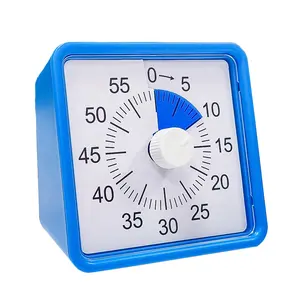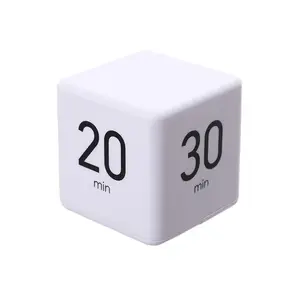(2433 products available)
































































































































































































































There are several types of 60-minute electrical timers, differentiated by their mode of operation, features, and intended application.
In the case of a mechanical timer, the time is set by turning a dial. This is done to wind up a spring. As the dial turns, the spring unwinds, which gradually turns the dial. This is called the escarpment, and it releases small amounts of energy from the spring to turn the hands of the clock. Mechanical timers are built simply, and users can rely on them without any advanced features. A mechanical timer is often appropriate for basic timing functions. Most mechanical timers will allow users to time an hour and give an audible signal once that hour is finished.
A digital timer counts time through an internal electronic clock that uses flip-flops to divide the frequency. This is done because; the main clock signal, which is produced by the oscillator, has to be divided into very small time units to give an accurate period counting. Flip-flops are stable and can always remember their state, which helps in the correct time count. The timer will include a display screen that will show the amount of time that has passed. Users will set the timer using buttons or a touchscreen, and these timers are often customizable to more than 60 minutes. Digital timers are often used where precise measurements are requested, such as in cooking or laboratory environments.
An in-wall timer is an electrical timer mounted in a wall switch box to control the electricity supply to circuits, outlets, lighting fixtures, or appliances plugged into a power receptacle. It does this by establishing on and off time periods through means such as time bands, time setting, and time program. Users will insert the timer into an electrical box inside a wall and control the power flow through appliances or devices.
A programming timer allows the user to set different time intervals for different days or parts of the day. It is a type of digital timer, but it is more complicated. The primary use of this timer is where machinery, lights, and HVAC (heating, ventilation, and air conditioning) systems should be controlled at specific times, such as offices and commercial buildings. With this timer, the users could also set the range of hours and days that the devices needed to be turned on or off.
So, regarding the above as common questions and answers, the durability and the materials of a 60-minute timer are as follows: With the understanding that these timers should be able to withstand every daily use, it is important to focus on the parts of each timer that make it durable.
First, the external housing of a 60-minute electrical wall timer is made from stronger materials like polycarbonate or ABS plastic. Other materials that are closely related to this, such as metals, are meant to protect the internal components from damage due to impact, moisture, and dust. Polycarbonate is a strong and transparent thermoplastic that is shatter-resistant. ABS stands for Acrylonitrile Butadiene Styrene, a hard thermoplastic that can resist impact and chemical damage. These materials are also used in making digital timers. Digital timers have external housings made from such durable plastic materials as polycarbonate or ABS. These materials are strong and resistant to impact and weather. LCD screens used for display are made from glass or plastic for added durability.
For mechanical mechanical timers, the internal components are often made of metal. These materials include steel, bronze, brass, and other extremely durable materials. Steel is well known for its durability. It is used to make most of the mechanical parts. These materials include gears, springs, and levers. In addition, the timer's winding spring is usually made from high-quality steel or bimetallic strips. Bimetallic strips consist of two different types of metals bonded together that expand and contract with changing temperatures. As a result, exposure to consistent use, as well as wear and tear, are greatly minimized.
Other features that also increase the durability of a 60-minute timer include quality seals and gaskets, which help prevent moisture and dust from entering. This feature is very important, especially in environments that are exposed to extreme weather conditions. In digital timers, more durable components such as quartz crystals or associates with ceramics will be used. These materials generally have good resistance to wear and tear due to heat. Signal capacitors are usually made of ceramic. It helps the circuit to have good signal integrity and stability.
Finally, the design of the timer will help it be very durable. A good design will ensure that all the parts are in the right position so that the forces acting on them will not cause damage. The timer's components are mounted in such a way that the mechanical stress caused during operation is evenly distributed.
The following are some examples of commercial use of a 60-minute electrical timer.
In industries such as manufacturing and processing, machines often go through several different cycles of operations. A 60-minute timer is used in these companies to help regulate these cycles and, therefore, increase productivity. For instance, a machine that needs to operate for 30 minutes and then cool off for 15 minutes can be easily programmed with this timer. Hence, it helps users complete processes using time efficiency while avoiding overuse of machines.
In the hospital, electrical timers play a very important role because most of their workings depend on accuracy, especially in medication administration and treatments. For example, intravenous (IV) therapies must be done according to specific intervals, and a 60-minute timer can be useful to nurses so that these procedures can be done within a certain time frame. Furthermore, in laboratories, these timers are crucial in experiments and tests where time-controlled chemical reactions need to be monitored.
In the catering business, all the appliances used to prepare food are usually timed to ensure that food is properly prepared. Timers help these users prevent undercooking or overcooking of foods, which could lead to loss of resources. In addition, they will help the kitchen staff multitask effectively as different dishes require different cooking times.
In greenhouses, a 60-minute timer is often used to control irrigation systems and other automated processes like fertilization and pest control. The timer can be used to set the water supply to plants for 60 minutes and then automatically stop. This is important, especially in automated agriculture systems, because it helps conserve water while preventing overexposure or underexposure of plants.
Maintenance work in facilities such as offices, schools, and commercial buildings requires a 60-minute timer to help with the scheduling of tasks such as cleaning, painting, or even repairing. With this timer, the technicians work within specific timeframes, which does not inconvenience the users and optimally brings finishes to the services.
Different parameters should be taken into consideration when choosing the best 60-minute electrical timer. The following factors should be taken into consideration:
Type of Timer
The first thing that has to be done is determine what type of timer will serve the relevant purpose the best. A mechanical timer is appropriate when there is little need for precision and more for practicality. Digital timers are the ones that provide extra accuracy; thus, they are useful in industrial and laboratory uses with a need for more flexibility in time setting. In-wall timers are great solutions for long-term running and control over devices and systems.
Ease of Use
Simultaneously, the ease of use is important, especially in commercial applications where users have to switch timers frequently. Digital and programmable timers usually come with easy-to-read LCD screens and simple button controls, whereas other art timers, such as mechanical timers, can have rotating knobs that are easy to operate. Ensure the user interface is suitable for the user's operational needs because accuracy in setting the timer will directly impact the reliability of timing.
Durability
Another very important criterion when choosing a 60-minute electrical timer is its endurance and reliability. For example, in industries and commercial applications, devices generally have to run continuously for a long period of time, and therefore, it is necessary not to interrupt operations with a faulty timer. Materials like polycarbonate or metals make the timer very tough and can last in harsh working environments. Water and dust resistance also contribute significantly to the exterior protection of the timer.
Additional Features
Sometimes, other features that are not basic but might be useful can also be incorporated into the timer. For example, features such as a countdown display, audible alerts, and programmability can be advantageous to the user in specific cases. Furthermore, if a programmable timer has extra flexibility, it can, therefore, be used in different timing tasks.
Power Source
A 60-minute electrical timer can be either battery-powered or electrically connected. While corded timers may be more reliable for long-term use, battery-powered timers offer portability. This is especially worth it in places where there is no power supply. If it is an electrically driven timer, make sure it is energy efficient so that the electric bills do not rise.
A: Mechanical timers are applied in industries, laboratories, catering, and hospitals. Digital timers are applied in precision timing, such as cooking, scientific research, and industrial processes. Timers applied in-wall switches are meant for controlling power in electrical systems.
A: Mechanical timers use internal clocks that are made of metal to keep time, while digital timers use electronic circuits. Mechanical timers are hands-on and were set by turning a dial, while the digital timers had buttons or touch screens.
A: Although mechanical timers are generally recognized for their accuracy, it may not be as much as digital timers. Nonetheless, mechanical timers are capable of providing reasonably accurate timing in areas that do not require accuracy, such as a cooking area.
A: Yes, a digital timer can be used outdoors; however, it is necessary to ensure it is housed in a water- and dust-proof enclosure so that weather conditions do not affect its function.
A: Ensure the external casing is made of sturdy materials like polycarbonate or metal and that internal components like capacitors are of high-quality materials.
A: Other features include a countdown indicator, programmability, and having both dust and water resistance.